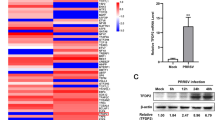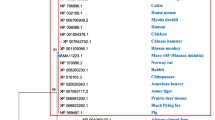Abstract
Protein kinase R (PKR) is involved in apoptotic cell death and antiviral activities in response to many virus infections. To reveal the role of PKR in the replication of porcine reproductive and respiratory syndrome virus (PRRSV), we first examined the kinetics of PKR phosphorylation during PRRSV infection. The results showed that PRRSV transiently activates PKR at 12 and 24 h postinfection. Surprisingly, eIF-2α, the well-known downstream target of PKR, was significantly phosphorylated compared to mock-infected cells only at 48 and 72 h postinfection. Reduced viral gene transcription, viral protein synthesis, and virus titer were detected in cells transfected with PKR silencing RNA prior to PRRSV infection compared to control silencing RNA transfected cells, indicating a role of PKR in facilitating virus replication. Overall, our data suggest that PKR is not a major contributor to the phosphorylation of eIF-2α during PRRSV infection, but it plays a pro-viral role in PRRSV replication by modulating primarily viral gene transcription.


Similar content being viewed by others
References
Adair R, Patel AH, Corless L, Griffin S, Rowlands DJ, McCormick CJ (2009) Expression of hepatitis C virus (HCV) structural proteins in trans facilitates encapsidation and transmission of HCV subgenomic RNA. J Gen Virol 90:833–842
Arnaud N, Dabo S, Maillard P, Budkowska A, Kalliampakou KI, Mavromara P, Garcin D, Hugon J, Gatignol A, Akazawa D, Wakita T, Meurs EF (2010) Hepatitis C virus controls interferon production through PKR activation. PLoS One 5:e10575
Barry G, Breakwell L, Fragkoudis R, Attarzadeh-Yazdi G, Rodriguez-Andres J, Kohl A, Fazakerley JK (2009) PKR acts early in infection to suppress Semliki Forest virus production and strongly enhances the type I interferon response. J Gen Virol 90:1382–1391
Cai R, Carpick B, Chun RF, Jeang KT, Williams BR (2000) HIV-I TAT inhibits PKR activity by both RNA-dependent and RNA-independent mechanisms. Arch Biochem Biophys 373:361–367
Dauber B, Martinez-Sobrido L, Schneider J, Hai R, Waibler Z, Kalinke U, Garcia-Sastre A, Wolff T (2009) Influenza B virus ribonucleoprotein is a potent activator of the antiviral kinase PKR. PLoS Pathog 5:e1000473
Diamond MS, Harris E (2001) Interferon inhibits dengue virus infection by preventing translation of viral RNA through a PKR-independent mechanism. Virology 289:297–311
Garaigorta U, Chisari FV (2009) Hepatitis C virus blocks interferon effector function by inducing protein kinase R phosphorylation. Cell Host Microbe 6:513–522
Garaigorta U, Heim MH, Boyd B, Wieland S, Chisari FV (2012) Hepatitis C virus (HCV) induces formation of stress granules whose proteins regulate HCV RNA replication and virus assembly and egress. J Virol 86:11043–11056
Hakki M, Marshall EE, De Niro KL, Geballe AP (2006) Binding and nuclear relocalization of protein kinase R by human cytomegalovirus TRS1. J Virol 80:11817–11826
Hakki M, Geballe AP (2008) Cellular serine/threonine phosphatase activity during human cytomegalovirus infection. Virology 380:255–263
Huo Y, Fan L, Yin S, Dong Y, Guo X, Yang H, Hu H (2013) Involvement of unfolded protein response, p53 and Akt in modulation of porcine reproductive and respiratory syndrome virus-mediated JNK activation. Virology 444:233–240
Irving AT, Wang D, Vasilevski O, Latchoumanin O, Kozer N, Clayton AH, Szczepny A, Morimoto H, Xu D, Williams BR, Sadler AJ (2012) Regulation of actin dynamics by protein kinase R control of gelsolin enforces basal innate immune defense. Immunity 36:795–806
Krishnamoorthy J, Mounir Z, Raven JF, Koromilas AE (2008) The eIF2alpha kinases inhibit vesicular stomatitis virus replication independently of eIF2alpha phosphorylation. Cell Cycle 7:2346–2351
Leib DA, Machalek MA, Williams BR, Silverman RH, Virgin HW (2000) Specific phenotypic restoration of an attenuated virus by knockout of a host resistance gene. Proc Natl Acad Sci USA 97:6097–6101
Li S, Min JY, Krug RM, Sen GC (2006) Binding of the influenza A virus NS1 protein to PKR mediates the inhibition of its activation by either PACT or double-stranded RNA. Virology 349:13–21
Li Z, Okonski KM, Samuel CE (2012) Adenosine deaminase acting on RNA 1 (ADAR1) suppresses the induction of interferon by measles virus. J Virol 86:3787–3794
Lindquist ME, Mainou BA, Dermody TS, Crowe JE Jr (2011) Activation of protein kinase R is required for induction of stress granules by respiratory syncytial virus but dispensable for viral replication. Virology 413:103–110
Lloyd RE (2013) Regulation of stress granules and P-bodies during RNA virus infection. Wiley Interdiscip Rev RNA 4:317–331
Loving CL, Brockmeier SL, Ma W, Richt JA, Sacco RE (2006) Innate cytokine responses in porcine macrophage populations: evidence for differential recognition of double-stranded RNA. J Immunol 177:8432–8439
Marciniak SJ, Yun CY, Oyadomari S, Novoa I, Zhang Y, Jungreis R, Nagata K, Harding HP, Ron D (2004) CHOP induces death by promoting protein synthesis and oxidation in the stressed endoplasmic reticulum. Genes Dev 18:3066–3077
McAllister CS, Taghavi N, Samuel CE (2012) Protein kinase PKR amplification of interferon beta induction occurs through initiation factor eIF-2alpha-mediated translational control. J Biol Chem 287:36384–36392
Nishitoh H (2012) CHOP is a multifunctional transcription factor in the ER stress response. J Biochem 151:217–219
Overend C, Mitchell R, He D, Rompato G, Grubman MJ, Garmendia AE (2007) Recombinant swine beta interferon protects swine alveolar macrophages and MARC-145 cells from infection with Porcine reproductive and respiratory syndrome virus. J Gen Virol 88:925–931
Oyadomari S, Mori M (2004) Roles of CHOP/GADD153 in endoplasmic reticulum stress. Cell Death Differ 11:381–389
Posti K, Leinonen S, Tetri S, Kottari S, Viitala P, Pelkonen O, Raunio H (1999) Modulation of murine phenobarbital-inducible CYP2A5, CYP2B10 and CYP1A enzymes by inhibitors of protein kinases and phosphatases. Eur J Biochem FEBS 264:19–26
Rivas-Estilla AM, Svitkin Y, Lopez Lastra M, Hatzoglou M, Sherker A, Koromilas AE (2002) PKR-dependent mechanisms of gene expression from a subgenomic hepatitis C virus clone. J Virol 76:10637–10653
Rojas M, Arias CF, Lopez S (2010) Protein kinase R is responsible for the phosphorylation of eIF2alpha in rotavirus infection. J Virol 84:10457–10466
Rowland RR, Robinson B, Stefanick J, Kim TS, Guanghua L, Lawson SR, Benfield DA (2001) Inhibition of porcine reproductive and respiratory syndrome virus by interferon-gamma and recovery of virus replication with 2-aminopurine. Arch Virol 146:539–555
Stojdl DF, Abraham N, Knowles S, Marius R, Brasey A, Lichty BD, Brown EG, Sonenberg N, Bell JC (2000) The murine double-stranded RNA-dependent protein kinase PKR is required for resistance to vesicular stomatitis virus. J Virol 74:9580–9585
Wang X, Eaton M, Mayer M, Li H, He D, Nelson E, Christopher-Hennings J (2007) Porcine reproductive and respiratory syndrome virus productively infects monocyte-derived dendritic cells and compromises their antigen-presenting ability. Arch Virol 152:289–303
Wang X, Liao Y, Yap PL, Png KJ, Tam JP, Liu DX (2009) Inhibition of protein kinase R activation and upregulation of GADD34 expression play a synergistic role in facilitating coronavirus replication by maintaining de novo protein synthesis in virus-infected cells. J Virol 83:12462–12472
Wang X, Zhang H, Abel AM, Young AJ, Xie L, Xie Z (2014) Role of phosphatidylinositol 3-kinase (PI3K) and Akt1 kinase in porcine reproductive and respiratory syndrome virus (PRRSV) replication. Arch Virol 159:2091–2096
Williams BR (1999) PKR; a sentinel kinase for cellular stress. Oncogene 18:6112–6120
Yoshida H, Matsui T, Yamamoto A, Okada T, Mori K (2001) XBP1 mRNA is induced by ATF6 and spliced by IRE1 in response to ER stress to produce a highly active transcription factor. Cell 107:881–891
Zhang H, Guo X, Nelson E, Christopher-Hennings J, Wang X (2012) Porcine reproductive and respiratory syndrome virus activates the transcription of interferon alpha/beta (IFN-alpha/beta) in monocyte-derived dendritic cells (Mo-DC). Vet Microbiol 159:494–498
Zhang P, Samuel CE (2007) Protein kinase PKR plays a stimulus- and virus-dependent role in apoptotic death and virus multiplication in human cells. J Virol 81:8192–8200
Zhang P, Jacobs BL, Samuel CE (2008) Loss of protein kinase PKR expression in human HeLa cells complements the vaccinia virus E3L deletion mutant phenotype by restoration of viral protein synthesis. J Virol 82:840–848
Acknowledgments
This study was partly supported by grants from USDA NIFA 2012-67016-19507 and South Dakota Agricultural Experiment Station.
Author information
Authors and Affiliations
Corresponding author
Rights and permissions
About this article
Cite this article
Wang, X., Zhang, H., Abel, A.M. et al. Protein kinase R (PKR) plays a pro-viral role in porcine reproductive and respiratory syndrome virus (PRRSV) replication by modulating viral gene transcription. Arch Virol 161, 327–333 (2016). https://doi.org/10.1007/s00705-015-2671-0
Received:
Accepted:
Published:
Issue Date:
DOI: https://doi.org/10.1007/s00705-015-2671-0




